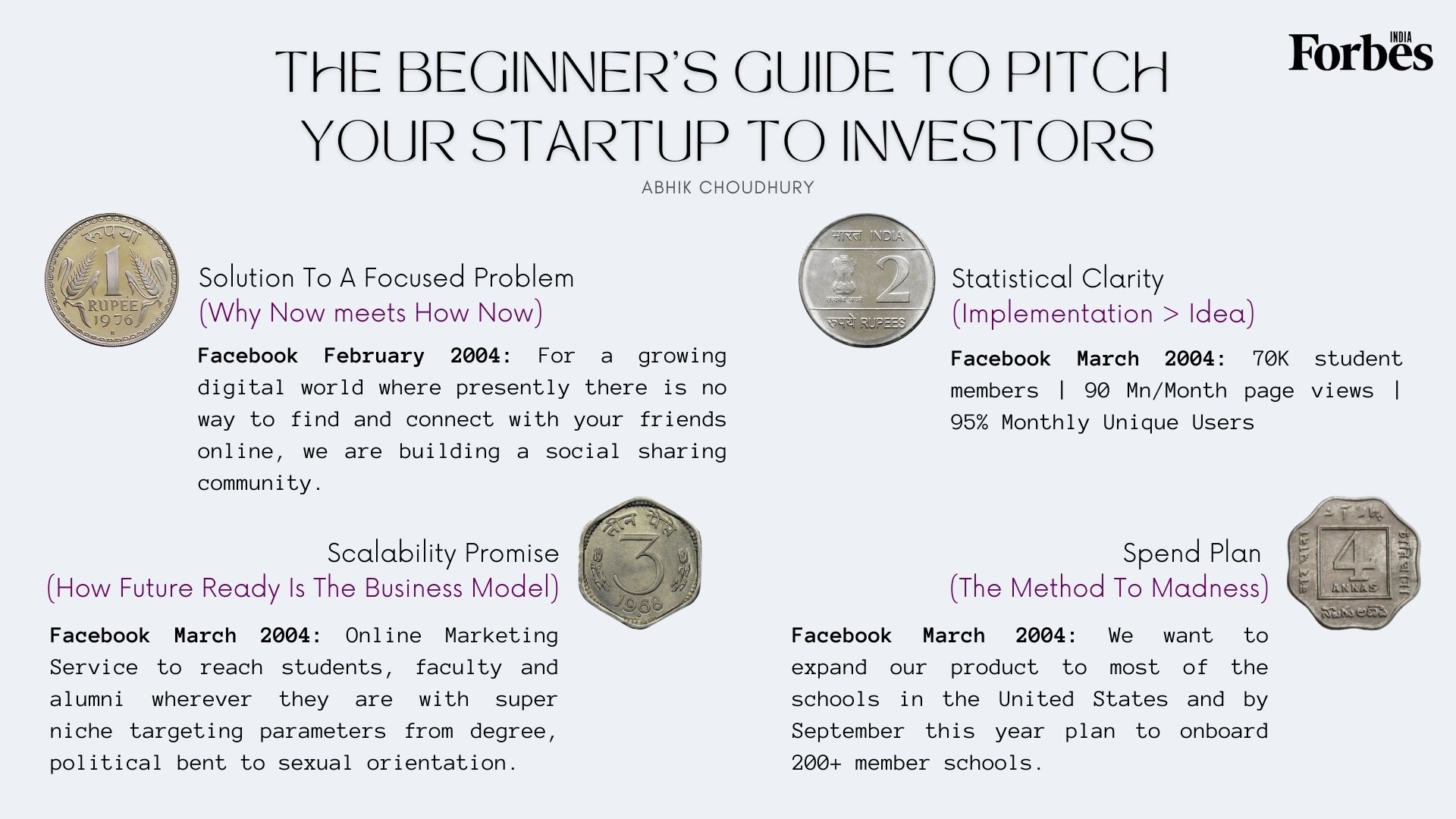A beginner's guide to pitch startup ideas to investors
An outline to launch a business for all those who don’t have an MBA degree from a fancy B-school, because that should never come in the way of getting a good deal
India has the third-largest startup ecosystem in the world with about 60,000 startups. And it successfully raised $42 billion last year. Both these numbers are meant to grow at record speed in the next three years, and so will the need of these new founders to make a pitch deck to raise funds from pre-seed, seed, series A to series F.
Now most entrepreneurs in India do not have MBA degrees from fancy B-schools. They are modest traders, inventors and artists turned entrepreneurs who don’t deserve to be left behind just because they weren’t taught how to articulate their purpose and mission in a way that makes sense to the financier. So this is for them, the outline you should always have in mind when you go for a meeting to raise money.
The problem articulation
Why does the world need what you’re doing right now? The entry point is crucial to success. Too early, you’re shunned; too late, you’re oblivious. So before you jump to the USPs (unique selling points) and strengths of your startup, always clarify the present need for it. The world doesn’t need another cryptocurrency but if you have a way to massively get the power consumption down by making the mining completely recycled energy-driven, then we are talking.
For Dropbox, it would have been on the lines of, ‘In this emerging digital world, no matter where you’re in the world, your share-ready, compress-friendly data will be with you’. For Airbnb, the pitch crux was, ‘Soaking customised local culture in affordable pricing and independence that big hotels looking like each other’s clones around the world can’t deliver’.
And this clarity right at the inception will help you multifold in control, growth and navigation of your startup in the right direction.
The spotlight identification
Don’t solve all the problems in the market. No one can at once. There would be other players in the same segment looking at it from another angle and your refreshingly new focus point can make all the difference. Match your offerings with the problems you are most well-equipped to solve and put the pedal on the metal. Ask yourself, do you want to be a trader or a brand?
A cheap, unorganised, local fashion market sells everything and so is not known for that ‘something’. And equally important, especially before you say ‘but Amazon does everything’, please calculate the resources you have right now. If you have only two arrows to shoot the target, how much focus do you need? Even Amazon started only by selling books online when no one was, and Uber was solving the problem of guaranteed pickup in faster turnaround before food delivery and their present self-driving investments. When you have warehouses full of arrows you can diversify into everything, till then—surgical precision, please.
The metrics clarity
A good pitch makes its concept clear for a middle schooler. A great one also makes you believe in it through undeniable numbers. Have every data point handy before entering that boardroom and not just the top line, bottom line and burn rate.
The most important research however isn’t actually the market size and competition, they both are constantly expanding and evolving for every single industry. TikTok happened when every expert said the social media market is completely saturated and has way too many billion dollar competitors. What will make you confidently stand out is your audience study—the why, when, what and how of their every move. Know them like you know your family. Real customer surveys about their experience with your brand work like a charm for an opening section for this.
If you’re in the content industry, your investors would possibly be very interested in your DAU (daily active users) to MAU (monthly active users) ratio, retention curve and average time spent per user. If you’re into FMCG, the basket size (AOV), sale frequency and CPA (cost per acquisition) is important to gauge the promise of your product line.
When you’re in that boardroom, the analyst's job is to poke holes in your narrative and venture to see how long you can float through your pitch. A small trick is to internally create a hundred question list that your biggest critic will ask you if you were in the same room. ‘Why did you choose audience A when audience B has more paying capacity?’, ‘By when do you predict becoming profitable?’ or the one asked in eight out of ten boardrooms: ‘What happens when others steal your idea?’ (Cheat code: In 90 percent cases maximising efficiency in logistics is the right answer. If your distribution penetration and warehousing is top of the line, you will thrive even if you’re a good grocery ecommerce or EV food truck. It isn’t necessarily true though for a great cookie marketing campaign, the customer would buy another cookie if that brand isn’t available in the local store at the time.)
The scalability plan
Investors put money on the promise of tomorrow than the guarantee of today. It’s great you’re generating X right now but how aligned are you to reach 100X in three years with your revenue stream and present business model. It is also imperative that your visions align with theirs, more so when entering a cluttered market. They are looking for that overview plan, not all fleshed out micro schedules but definitely the intention and capability through a confident macro concept. Pro tip: Dance on the edge of being fairy tale and believable, too much on either side hurts credibility. Uber had literally proposed—best, realistic and worst case scenario in the same slide of their 2008 pitch.
Buzzfeed promised during round one of the pitch—they will ‘dramatically grow traffic without hiring editors’, and make a profitable revenue stream by looking at ‘advertising as content’ and ‘trend targeting’. So before you enter that meeting, it is advisable to at least know some benchmarking and strategic routes you are aiming for in the next couple of years.
The budgeting
When you approach an investor for money, your chances of approval find a comfortable edge if you can etch out the spending plan. You will be trusted when you have a shield of budget mapping at least a year’s plan to successfully scale with the capital you are looking to raise. And if you’re a first time entrepreneur you don’t need to go into the nuances with an in depth excel, that can always follow and evolve but unless you’re already a successful entrepreneur going for your second or fourth big pivot, it usually shouldn’t be an open-ended ask.
“We need one million for our startup against X percent equity” versus “We need one million to expand our product team, put a quarter of that money on marketing including e-commerce deals and another on operations to bring costs down by 35 percent by completely streamlining our distribution internally from the present third party arrangement and are offering X percent equity dilution for the same.” Think as an investor, who will you trust more with your money?
Raising money and diluting equity is a long game with longer repercussions, try to be as knowledgeable about your offer and expectation as possible. And summarise the above points even while writing cold emails to VCs or angel investors. May your venture elevate both your ambitions and the category itself. Go be the sun.
The writer is the chief strategist & founder of Salt and Paper Consulting. Views and opinions expressed here are personal.
The thoughts and opinions shared here are of the author.
Check out our end of season subscription discounts with a Moneycontrol pro subscription absolutely free. Use code EOSO2021. Click here for details.


